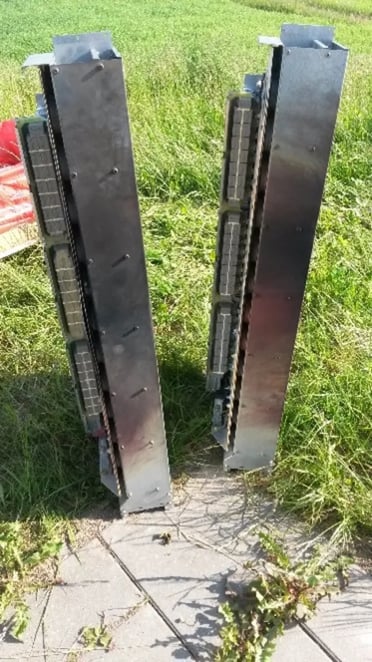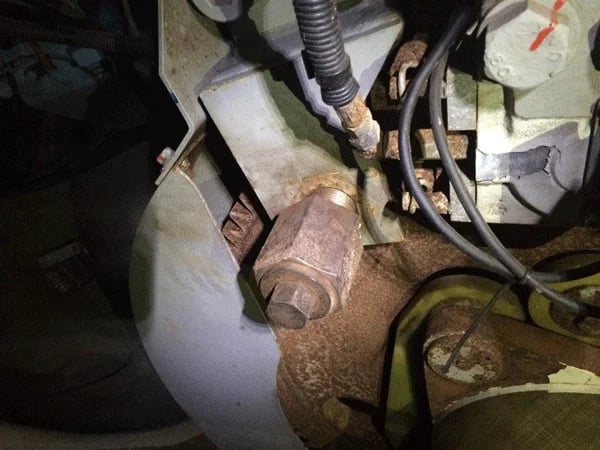Wind turbines are exposed to the elements and the persistent onslaught of mother nature 24/7, 365 days a year. A range of studies over the years links climatic conditions to internal and external wind turbine failure, both in direct-drive and geared-drive wind turbines to varying degrees. Cotes can't keep your wind turbine dry on the outside, but on the inside, where there are loads of critical electrical systems and mechanical components to keep dry, Cotes can dry the air, filter salt from the air, and create an overpressure to keep moist air out and dry air in. Cotes dry air solutions can easily be retrofitted inside WTGs onshore, nearshore and offshore. It is never too late to take control of humidity.
External wind turbine failures
The most common external wind turbine failure is typically damage to the blades caused by bird strikes, lightning strikes, rainfall, blade furniture detachment, delamination, leading-edge corrosion or blade cracks. The frequency and severity of external wind turbine failures are outside of Cotes' expertise, literally and figuratively, as Cotes primarily focuses on internal wind turbine failures.
Internal wind turbine failures
Inside the nacelle and tower, you have sensitive electronic systems and critical components, so, unsurprisingly, the most common failures inside a wind turbine are: 1) Electrical failures 2) Mechanical failures.
Electrical and mechanical failures have a detrimental effect on a wind turbine's production output, uptime, performance, and reliability. If the line converter experiences a short circuit or the gearbox breaks down, you could face a full stop of the turbine and loss of production.
Electrical Wind Turbine Failures
 Image above: A damaged Delta modules that had to be replaced due to humidity creating short circuits.
Image above: A damaged Delta modules that had to be replaced due to humidity creating short circuits.
Electrical failures are expensive and, unfortunately, the most common failures we see inside wind turbines. Fraunhofer investigated humidity-related electrical failures inside wind turbines and concluded that the temperature and humidity conditions inside the converter cabinets contributed to a cabinet-internal climate found to be subject to pronounced seasonal variations leading to increased electrical failures, but the issue extends beyond the converter cabinet.
No wind turbine is airtight so you will always have air filtering through from the outside into the wind turbine carrying moisture [and salt depending on location]. Condensation forms on cold surfaces inside the tower and nacelle when relative humidity exceeds 60%. When condensations forms on a surface it will run down and collect at the bottom of the tower or nacelle, or in some cases collect inside electrical components, risking electrical failures and costly downtime.- Read more on the formation of mould inside wind turbines
- Explore the Cotes Global Corrosion index that connects historical weather data with wind turbine locations around the world
Site-specific ambient climatic conditions and the operation of the turbines all contribute to excessive levels of humidity, and if not properly protected, all electrical systems are at risk, Cotes offer clients the opportunity to set up a humidity test for electronic
Most wind turbines require up to 24hrs preheating cycles to avoid electrical problems during start-up after periods of standstill. The preheating process can be minimised or even avoided entirely by proper humidity control or protection during standstill - increasing uptime and power production.
Cotes offers a proven dry-air solution to avoid these types of internal electrical failures caused by humidity. Simply stated, Cotes helps you avoid electrical faults by removing moisture from the air, filtering salt from the air (if present), and creating an overpressure inside the wind turbine - keeping relative humidity under 60% all year round.
Mechanical Wind Turbine Failures
 Image above: Corrosion on critical mechanical components inside the WTG
Image above: Corrosion on critical mechanical components inside the WTG
Mechanical failures are less frequent but just as detrimental to wind turbines over a longer period of time. Metal components react to moisture and, over time will weaken and degrade the mechanical parts such as the gearbox, bearings, and yaw gear - risking component failure and an inoperable wind turbine that requires a service team (if the weather allows). Mechanical failures are costly and take time to repair, and time is money. Mechanical failures can be avoided in the long run with better humidity control inside the wind turbine using a Cotes adsorption dehumidifier.
“One of the main electrical faults I hear about is short circuit due to condensation. This typically occurs after a standstill, either planned or not. Often this will cause components to be damaged and will need replacement, or at best just reduce the wind turbine’s lifetime,” Keld Selchow Bonnez, Cotes Senior Design Engineer for Technical Wind.
%20(1)-1-1.webp?width=1315&height=930&name=Plakatbilleder%20uden%20logo_Page_04_Image_0001%20(1)%20(1)-1-1.webp) Image above: Keld Selchow Bonnez retrofits a Cotes dry-air solution (adsorption dehumidifier) specially designed for wind turbines.
Image above: Keld Selchow Bonnez retrofits a Cotes dry-air solution (adsorption dehumidifier) specially designed for wind turbines.
Create your own dry-air strategy
When you experience electrical failures and corrosion due to uncontrolled levels of humidity [and salt] you need to consider the following:
- Wind farm climatic condition - Where is your wind turbine situated? Offshore, nearshore or onshore? We see onshore wind turbines being exposed to the offshore type of climatic conditions because of their proximity to the coastline with the incorrect corrosion class. Explore
- Wind turbine corrosion class - Is your wind turbine designed for the environment it will be exposed to? Wind turbines are ill-equipped for the higher corrosion class climatic condition with little or no consideration to avoiding humidity issues. With the right dry-air strategy, you can reduce the corrosion class without jeopardising the wind turbine.
- Wind turbine lifetime - Wind farm owners expect far more operational years from their wind turbine assets than what they intended. It is possible to get more years from your WTG, but you have to keep the relative humidity inside your turbine under 60%; otherwise, you risk electrical and component failures, expensive downtime, and a shortened wind turbine lifespan.
- Wind turbine dry-air strategy: We see the most effective way to combat the corrosive effects of humidity [and salt] inside wind turbine nacelles and towers is to create a dry and salt-free environment inside your turbine where it matters the most.
SIEMENS GAMESA DRY-AIR STRATEGY USING ADSORPTION [DESICCANT] DEHUMIDIFICATION
There is a broad consensus in the wind industry, and especially with our long-time clients, OEMs and developers, that the principle of adsorption is the only technology suitable for the dehumidification of wind turbines. In addition to being service stable, the technology also works in sub-zero temperatures. We asked Jens Schiersing Thomsen, a Senior Expert at Siemens Gamesa Renewable Energy, what his take on the role of dehumidifiers are in avoiding corrosion and electrical faults inside wind turbines.
Connect with Keld Selchow Bonnez, Cotes Senior Design Engineer for Technical Wind, on LinkedIn.
Connect with Benjamin Troskie, Cotes Senior Specialist Marketing and Communication, on LinkedIn.
Connect with Jens Schiersing Thomsen, Key Expert for Siemens Gamesa Renewable Energy, on LinkedIn